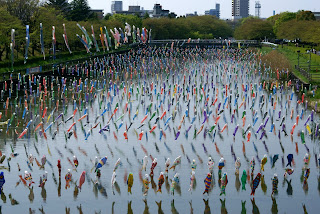By, Uwe Paschen.
As it goes here in Japan we have yet another holiday.
This time it is the Golden Week, (ゴールデンウィーク), Which is also known as Ōgata renkyū (大型連休) or even as Ōgon shūkan (黄金週間), those are terms in Japanese to describe this period of the year wish contains several events starting with the 29th of April where we celebrate(d),
Until 1988 it was Emperor's Birthday (天皇誕生日 Tennō tanjōbi),
Since 2007 this day is now known as Shōwa Day (昭和の日 Shōwa no hi).
This is followed by Constitution Memorial Day (憲法記念日 Kenpō kinenbi) on the 3th of May.
And by the Greenery Day, or Nature Day (みどりの日 Midori no hi) since 2007 on the 4th of May wish used to be called (国民の休日 Kokumin no kyūjitsu), from 1985 until 2006.
Then on the 5th of May comes the Children's Day (こどもの日 Kodomo no hi), also customarily known as Boys' Day (端午の節句 Tango no sekku)). Since earlier this year we had the Girls Day or also called the Dolls Day, which is Called the Hinamatsury, here in Japan. This is the Japanese, (雛祭り Hina-matsuri), or Girls' Day, Hinamatsuri which was held on March 3, the third day of the third month.
Note that China does have a Golden Week (黄金周) as well, yet theirs is some what different then ours here in Japan.
The best part of the Japanese Golden Week is of course the day set aside to respect the children individually and to celebrate their happiness. It was designated a National holiday by the Japanese government in 1948.
And all Children and especially the Boys as well as the whole Family are looking forward to that day, which is field with Family outings and activities as well as many preparations that need to be taken care of well ahead of this week.
Such as the most important Koinobori, which is sort of a kite or kites that fly on a pole by each house and through out each town. Those kites are in shape of a Carp, (The large carp at the top represents the father, the second carp represents the eldest son, and additional carps are added to represent each subsequent son with colours and position denoting their relative age.)
The name of this day comes from Sakata no Kintoki whose childhood name was Kintarō (金太郎 ), He was a great hero in the Heian period, a subordinate samurai of Minamoto no Raikou, having been famous for his strength when he was a child. It is said that Kintarō rode a bear, instead of a horse, and played with animals in the mountains when he was a young boy. So the legend.
The festival was funded during the reign of the Empress Suiko (593–628 A.D.). In Japan, Tango no Sekku was assigned to the fifth day of the fifth month after the Nara period and has been celebrated ever since.
Each families raises the carp-shaped koinobori flags (carp due of the Chinese legend stating that a carps swims upstream becoming a dragon. The flags blowing in the wind look in deed like they are swimming and some what like Dragons as well). One for each boy (or child) is put up, on display with a Kintarō doll, which is usually riding on a large carp, and with the traditional Japanese military helmet, kabuto. Kintarō and the kabuto are both symbols of a strong and healthy boy.
The traditional food for this day is Mochi rice cakes wrapped in kashiwa (oak) leaves — kashiwa-mochi (just like regular mochi, but it is also filled with red beans jam) and chimaki (a kind of "sweet rice paste," wrapped in an iris or bamboo leaf).
Tatebayashi (館林市 Tatebayashi-shi.) this town is located in Gunma, Japan one hour from Tokyo, (by Express Ryomo) it is famous for the Azalea Hill Park(つつじヶ岡公園,Tsutsuji-ga-oka koen) and the Bunbuku Chagama of the Morinji Temple (茂林寺). However it is also famous for flying the most Carp Kites ever flown in Japan or any where around the globe, this broth it into the Guinness Book of records for the most Carp kites ever flown, namely 6066 Carp Kites in the park and along the river.
An amazing display, which has now become a costume every year, with some more kites being added each passing year.
What would this great day be with out a song? And it does have one in deed, written by Unnu Atsushi.
“Sei Kurabe (背くらべ Height Comparison)
柱のきずは おととしの 五月五日の 背くらべ
Hashira no kizu wa ototoshi no gogatsu itsuka no Sei-Kurabe
粽たべたべ 兄さんが 計ってくれた 背のたけ
Chimaki tabe-tabe nii-san ga hakatte kureta sei no take
きのうくらべりゃ 何のこと やっと羽織の 紐のたけ
Kinou kurabe-rya nan no koto, yatto haori no himo no take.”
Japan is rich in culture and traditions. Children are a blessing here and honoured as such.








